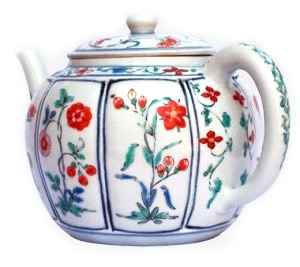The hexagonal, moulded, lobed body enamelled in the Kakiemon palette with flowering plants in each panel painted in blue, green, iron red and gold, below a band of flower sprays in iron red with turquoise enamelled veined leaves, the cover similarly decorated with vigorously painted flowers and leaves, the undecorated round knob with a hole drilled for steam to escape, above a band of iron red curlwork, the C shaped handle decorated with a continuous band of turquoise enamelled stylised sprigs, the upright spout similarly decorated.
Literature
For an identical example in the Ashmolean Museum, see Porcelain for Palaces; the fashion for Japan in Europe 1650 - 1750 by John Ayers, Oliver Impey, J.V.G. Mallet, with contributions by Anthony du Boulay and Lawrence Smith, published by the Oriental Ceramic Society, London 1990, page 145 plate 110."An eight-lobed melon-shaped teapot, the plain knob of the lid fitted with a gilt metal finial and secured by a chain to mounts on the handle and spout. In panels and bands outlined in underglaze blue and painted in Kakiemon enamels are eight different flowering plants round the sides, a floral scroll on the shoulder and a flower spray round the lid."
See also Soame Jenyns Japanese Porcelain, London, Faber & Faber, 1965, page 58 plate 78A. Jenyns writes 'One of the most interesting Japanese forms is that of the Kakiemon tea pots with the body divided into lobes like that of a canteloupe melon ..... Was this an export form or made for the indigenous market.
Plate 78b in the same book shows the exceedingly rare Chinese copy dating to about 10-15 years later than this rare original model. In fact on page 153 Soame Jenyns remarks on how rare the Chinese model is. It is interesting to note how closely the Chinese followed the Japanese model , one of the differences is that the Chinese used underglaze blue instead of the overglaze blue favoured by the Japanese. Both these pots shown by Jenyns in his book were bequested to the Fitzwilliam Museum Cambridge where they are today.

